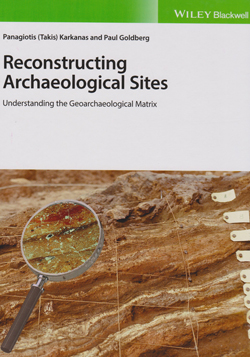
In 1987, Michael Schiffer published a 364-page brainstorming volume, synthesizing his own and others’ previous work, entitled
Formation Processes of the Archaeological Record. Schiffer himself admitted then that “the principles and techniques for identifying specific formation processes are not yet well developed” (1987:267), and he called for experimentation and refinement of techniques to monitor the multitudes of processes he identified. After 30 years,
Reconstructing Archaeological Sites fills that gap for one aspect of geological (sedimentary) processes—and this volume’s extensive bibliography provides a sampling of such work done on site formation processes in those intervening decades.
Karkanas and Goldberg are eminent geologists with extensive careers working on archaeological sites. They focus on the archaeological ‘deposit’, a three-dimensional matrix primarily containing sediments and objects (artefacts, ecofacts) that were deposited penecontemporaneously (2019:11)—the exception being architectural structures that are filled later. They emphasize that the “sediments accumulated by a certain process, and it is this process that explains the patterning of the artefacts”—even when the sediments are gone (deflated deposits) (2019:12-13); to ignore the sediments is to vastly underestimate and possibly misunderstand the artefactual information. Thus, the volume is devoted to discussing the formation and depositional nature of both natural and anthropogenic sediments, and their remains in site stratigraphy, in non-architectural and architectural sites. They also offer various approaches to studying sediments in the field, such as drawing, photographing and sampling.
Most geologists will be familiar with the processes producing and the properties of natural sediments. However, the discussion of anthropogenic sediments will possibly open new doors for the identification of human presence in otherwise seemingly geological deposits, if finely excavated (a trampled path through a hunting ground? an intentionally burned landscape?). One aspect not dealt with herein is the potential for artefacts and sites themselves to yield data on geological processes. Schiffer noted that so-called ‘soil-movement effects’ can be detected from abrasion or microflaking of stone tools (1987:11), while the direction and impact traces of rocks on an archaeological site that were carried by a pyroclastic flow can reveal the exact direction and speed of the flow (see
TephroArchaeology in the North Pacific, 2019:177).
Overall, this volume is a welcome guide to analyzing the sedimentary matrix of archaeological deposits, including artefacts as one element of matrix ‘fabric’. The authors decry the continuing lack of archaeologists’ sensitivity to sediments because without it, how else can one extract maximum information from the most common excavation product: ‘dirt’?
Reviewed by Gina L. Barnes
RECONSTRUCTING ARCHAEOLOGICAL SITES: UNDERSTANDING THE GEOARCHAEOLOGICAL MATRIX by Panagiotis (Takis) Karkanas & Paul Goldberg, 2019. Published by: Wiley Blackwell 279pp (hbk) ISBN: 9781119016403
List price: £75.00.
W: https://www.wiley.com/